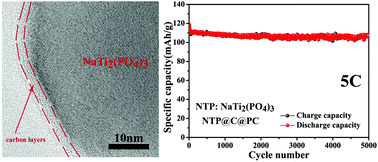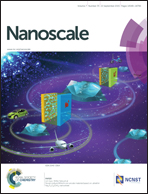A carbon coated NASICON structure material embedded in porous carbon enabling superior sodium storage performance: NaTi2(PO4)3 as an example†
Abstract
Sodium super ion conductor (NASICON) type structure materials (e.g. Na3V2(PO4)3, NaTi2(PO4)3) have been considered as promising electrode materials for sodium-ion batteries (NIBs). However, the inherent poor electronic conductivity of the NASICON type structure materials owing to their poor electronic conductivity of phosphates leads to poor cyclability and rate capability. Here, we develop a general strategy to achieve high rate capability and long cycle life by preparing “double carbon coating” NASICON NaTi2(PO4)3 using a soft-chemical method. The obtained carbon-coated NaTi2(PO4)3 within the porous carbon matrix (denoted as NTP@C@PC) imparts a reversible capability of 103 mA h g−1 at 5 C after 5000 cycles and a rate capability of 64 mA h g−1 at 50 C for sodium storage. The high capacity, stable cyclability and excellent rate capability of the NTP@C@PC are attributed to the advantages of the special structure: the fast Na+/e− transfer in the nanocomposites, large surface area and mesoporous nature of the 3D porous carbon matrix that facilitate the electrolyte to soak in, an intimate interaction between the particles and the carbon matrix. In addition, the 3D porous carbon matrix could effectively accommodate the volume variation during a repeated sodiation/desodiation process.


 Please wait while we load your content...
Please wait while we load your content...